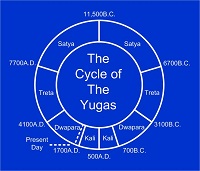What Is Kali Yuga?

A 2,400-year age of darkness. The recent ascending Kali Yuga lasted 1,200 years from 500 and 1700 AD. (1) Sri Yukteswar in The Holy Science described Kali Yuga as an age during which consciousness was limited to gross matter. (2)
During Kali Yuga, most people lost their spiritual abilities, mental clarity, and understanding. (3) The age was characterized by the belief that matter was fixed and absolute. For example, religious truths were only accepted as absolute definitions or dogma, and science presented the universe as a mechanism; the divine realms were imagined as static, instead of dynamic. (4)
Most people during the age, such as farmers, herdsman, artisans, soldiers, and slaves, were involved in physical labor. Activity was directed mainly toward physical ends such as food, clothing, and possessions. Even religious activity took the form of rituals and rigid offerings, sacrifices, and prayers. People were ignorant of their ability to change. This ignorance manifested in widespread attempts to destroy knowledge, for example in the third century destruction of ancient Egyptian texts at Alexandria. (2)
Not only ignorance but also lack of willpower hindered the ability of people to chance during Kali Yuga. Societies were divided in terms of castes or hierarchy, notably in India. Slavery was widely practiced around the world, and the Romans even killed their slaves as a brutal form of entertainment. Military conquests in this age were common, and civilizations built in walled cities and fortifications. Human and animal sacrifices, such as in Aztec societies, were attempts to bargain with the divine for material gains. In Kali Yuga, people accepted harsh and cruel conditions as basic to life. (2)
Within the physical realm, Kali Yuga people exhibited ingenuity and skill in engineering. By applying man power and animal power to building materials with an understanding of physical laws, people around the world were able to construct roads, temples, cathedrals, and buildings. Even civilizations far apart from each other has access to similar knowledge and resources. (2)
During Kali Yuga, most people functioned in low consciousness. But higher knowledge existed in monasteries, temples, and ashrams, where people directed themselves toward inward spiritual practice. Other high-minded artists and philosophers during the age were able to attain beauty, moral understanding, and consciousness through their works.
Current Hindu orthodoxy promotes the view that the world remains in Kali Yuga. Many scholars believe that the age lasts 432,000 years. (5) But Yukteswar noted that the duration had been arbitrarily calculated by converting divine to human years. He calculated instead that Kali Yuga, including 1,200-year descending and ascending times, lasts 2,400 years. (6) Most recently, the world emerged from ascending Kali Yuga into ascending Dwapara Yuga in 1700 AD. (5)
- ↩ Autobiography of a Yogi, by Paramhansa Yogananda. p. 167.
- a b c d The Yugas, by David Steinmetz and Joseph Selbie. Chapter 2, “The Kali Yugas”
- ↩ The Essence of the Bhagavad Gita, explained by Paramhansa Yogananda. pp. 175-176.
- ↩ Religion in the New Age, by Swami Kriyananda. Chapter 3, “What Is Happening to Our Planet?”
- a b The Hindu Way of Awakening, by Swami Kriyananda. Chapter 5, “Dating It All.”
- ↩ “The end of the Kali Yuga,” by Bibhu Dev Misra.
